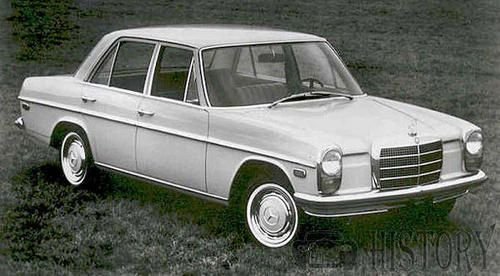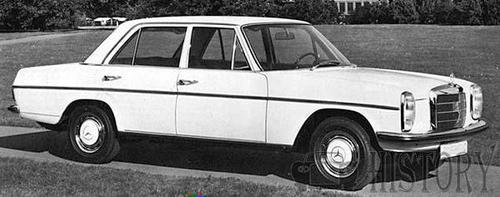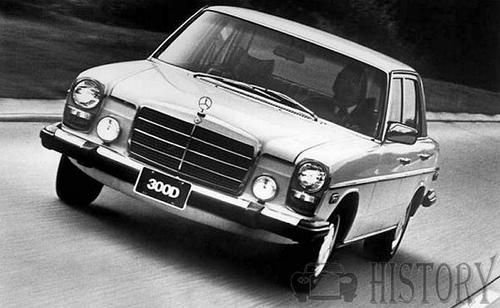Mercedes-Benz W114 W115 '/8' Range
200 220 230 240 250 280 300
 |
|
| Manufacturer | Daimler-Benz |
|---|---|
| Production | 1968–1976 1,919,056 built Saloon: 1,852,008 Coupé: 67,048 |
| Assembly | East London, South Africa Sindelfingen, West Germany Barcelona, Venezuela (CKD) Buenos Aires, Argentina |
| Predecessor | Mercedes-Benz W110 |
| Successor | Mercedes-Benz W123 |
| Class | Executive car |
| Body style | 4-door sedan 2-door coupe |
| Platform | FR layout |
| Engine | 2.0 L M115 I4 2.2 L M115 I4 2.3 L M115 I4 2.3 L M180 I6 2.5 L M114 I6 2,746 cc M110 I6 2,778 cc M130 I6 2.0 L OM615 diesel I4 2.2 L OM615 diesel I4 2.4 L OM616 diesel I4 3.0 L OM617 diesel I5 |
| Wheelbase | 108 in (2,700 mm) |
| Length | 184.25 in (4,680 mm) sedan/saloon and coupe with Euro-spec bumpers |
| Width | 69.75 in (1,772 mm) |
| Height | 56.75 in (1,441 mm) |
| Related | Mercedes-Benz W116 |
| Designer(s) | Paul Bracq |
The Mercedes-Benz W114 and W115 models are a series of coupes and sedans introduced in 1968 by Mercedes-Benz, manufactured through model year 1976, and distinguished in the marketplace by nameplates designating their engines.
W114 models featured six-cylinder engines and were marketed as the 230, 250, and 280, while W115 models featured four-cylinder engines and were marketed as the 200, 220, 230, and 240.
All were styled by Paul Bracq, featuring a three-box design. At the time, Mercedes marketed sedans in two size classes, with the W114/W115, positioned below the Mercedes-Benz S-Class.
Beginning in 1968, Mercedes marketed their model range as New Generation Models,giving their ID plates the designation '/8' (due to their 1968 Launch year). Because they were the only truly new cars of the so-called 'New Generation' and because of the '/8' or 'slash eight' designation, W114 and W115 models ultimately received the German nickname Strich Acht, loosely translated into the English Slash Eight.

History
The W114/W115 models were the first post-war Mercedes-Benz production car to use a newly engineered chassis, not derived from preceding models. The new chassis format of semi-trailing rear arms and ball-joint front end, first displayed in the W114/W115 chassis would be used in all new Mercedes passenger car models until the development of the multi-link rear suspensions of the 1980s. The W108/109 S-Class chassis of the 280S/8, 280SE/8 and 300SEL/8 (and W113 280SL Pagoda) would be the last of the low-pivot swing axle and king pin/double wishbone front ends. The next S-Class -the W116 chassis- having the same engineering of the W114/115.
The W114/W115 models replaced the W110 Fintail models stemming from 1961, and were themselves replaced by the W123 series after 1976.
The Mercedes-Benz W114/W115 was the mid-sized saloon model for Mercedes, positioned below the S-Class. Mercedes also launched its first 5-cylinder diesel engine OM617 in this chassis. It followed heavily in the direction set by the W108/109 S-class, which was launched in 1965 and heralded the new design idiom. The car was designed by French auto designer Paul Bracq who was chief designer at Mercedes-Benz for models from 1957 to 1967, a period that included models such as the Grosser Mercedes-Benz 600. Bracq was also responsible for BMW designs (1970–74) and Peugeot designs (1974–96).
The W114 received a facelift in 1973 - with a lower bonnet-line, lower and broader grill, a lower placement of the headlamps, A-pillar treatment for keeping the side windows clear, ribbed tail lights to minimize occlusion of the tail lights with road dirt, and larger side mirrors. The interior received inertia reel belts and a new padded steering wheel with a four-hole design.

Mercedes introduced a coupé variant in 1969 carrying the nameplate '250C/CE' or '280C/CE' and featuring a longer boot hood and a 2.8 litre six-cylinder engine. It is considered by enthusiasts to be one of the finest classics of the 1960s and 1970s, although this is not reflected in the prices of these cars which is generally less than its more popular contemporaries the Mercedes SL R107/C107 roadster and coupé (1971–1989) which featured the 3.5 or 4.5 litre V8 under the hood, and only a fraction of price commanded by the Pagoda models (1963–1971). While a 'hard-top' unlike the fully convertible SL, the pillarless design allowed all the windows could be lowered completely for open air motoring. Only 67,048 coupés were manufactured from 1969 to 1976 (vs. 1.852,008 saloons). Of these 24,669 were "280C" and "280CE" (top of the range), and 42,379 were the lesser "250C" and "250CE".
Innovations
Like its saloon variant this car also boasted advanced technological innovations. 1969 saw the introduction of the Bosch D-jetronic fully electronic fuel injection system into the 250CE. This was the first ever production Mercedes-Benz to use this system.
Other innovations in the W114/W115 models include a center console (a first in a Mercedes sedan), ribbed taillights in 1974. All coupe models used the 6-cylinder engine (and thus were W114s) and were designated with a "C" in the model name.
A Mercedes-Benz 220 D pickup on the W115 chassis was built briefly in Argentina in 1970s.

North America
The W114/W115 was introduced in North America in 1968, but with fewer engine choices than elsewhere. These models from the start had unique headlights, utilizing a sealed beam lamp instead of the H4 type used in the European models. Bumpers changed frequently and there were at least three different bumpers used over the production run in NA. For 1974 the bumpers grew significantly due to new DOT requirements.
North American 240Ds were offered with a 4-speed manual or 4-speed automatic, whereas all 5-cylinder 300D models were equipped with the 4-speed automatic without a manual option.

Technical
-
Models
W114
Chassis code Years Model Engine Number built Displacement Model Type W114.015 1968–1976 230, 230.6 2.3 L M180 I6 221,783 W114.01333 1968–1972 250 2.5 L M114 I6 78,303 W114.011 1972–1976 250 2.8 2.8 L M130 I6 34,061 W114.023/022 1969–1976 250C/CE 2.8 L M130 I6 42,379 W114.060/062 1972–1976 280/E 2.8 L M110 I6 67,373 W114.073/072 1972–1976 280C/CE 2.8 L M110 I6 24,669 W115
Chassis code Years Model Engine Number built Displacement Model Type W115.015 1968–1976 200 2.0 L M115 I4 288,785 W115.115 1968–1976 200D 2.0 L OM615 Diesel I4 339,927 W115.010 1968–1973 220 2.2 L M115 I4 128,732 W115.110 1968–1976 220D 2.2 L OM615 Diesel I4 420,270 W115.017 1973–1976 230.4 2.3 L M115 I4 87,765 W115.117 1973–1976 240D 2.4 L OM616 Diesel I4 131,319 W115.114 1974–1976 240D 3.0/300D 3.0 L OM617 Diesel I5 53,690 W115 long-wheelbase models
Chassis code Years Model Engine Number built. Displacement Model Type W115.112 1968–1973 200D Lang (LWB saloon) 2.0 L OM615 Diesel I4 4,027 W115.119 1973–1976 240D Lang (LWB saloon) 2.4 L OM616 Diesel I4 3,655 W115.017 1968–1976 230 Lang (LWB saloon) 2.3 L M180 I6 2,218 cars + 2,934 chassis
Manuals
-
Mercedes Benz Previous 70 / 83 Next
